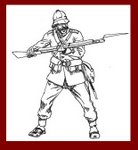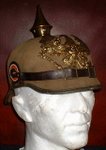
By Andy Cowell
"Assemble the army,
beat the drum!"
(1875-1896)
Most colonial-period wargamers are familiar with Napier's highly successful 1868 campaign against Mad King Theodore of the Abyssinians. What they sometimes don't realise is that Abyssinia offers much more than that for the nineteenth century wargamer.
Between 1875 and 1896 the Abyssinians fought off Egyptian, Dervish and (most famously) Italian invaders. This article will provide the background and a battle re-fight scenario for each of the three campaigns.
Part 1: The Egyptian Invasion of 1875
The Egyptians first invaded inland Abyssinia in October 1875, with a column of some 3400 men under the command of a Colonel Arendrup, a Dane in the service of the Khedive. The expedition was designed not necessarily to do any fighting, but to overawe the ignorant savages into accepting the fact that Egypt held the Massowah region, and to stop them constantly raiding into Egyptian-held territory.
Unfortunately, Arendrup severely underestimated his foe. Although accounts vary, it seems almost certain that he split his force into several parts, with the 800-strong section that he was leading being wiped out, along with their illustrious leader, in the defile of Goundet.
This slap in the face for the Egyptians could not go unpunished, so in December 1875 a second expedition was dispatched: numbering about 16,000 men under the command of Ratib Pasha and his American advisor, General Loring, who had fought in Mexico and was now in service to the Khedive.
This expeditionary force remained at Massowah for some months, but then moved some 80 miles inland. There, two forts were established. The closer, on the slopes of Mount Kayakhor being named Fort Kayakhor, and the other, six miles further inland, in a valley that effectively commanded the lines of communication for the area, Fort Gura.
Ratib Pasha had about 7,500 men at Fort Gura and 5,000 men at Fort Kayakhor: the rest being distributed between two more strong points established along the route back to Massowah.
Meanwhile, King Yohannes had gathered around 45,000 of his warriors and was heading towards the waiting Egyptians.
In the face of this obvious threat, rather than concentrate his forces at either Gura or Kayakhor, Ratib Pasha dithered: eventually marching 5,000 of his men out of Fort Gura to a position approximately midway between the two strong points!
Here, on 7th March 1876, the Abyssinians attacked: scoring a great victory over the Egyptian troops, who were abandoned by their officers as soon as their enemy came into view, and slaughtered like lambs in the confusion that followed.
Only some 500 immediately escaped back to Forts Gura and Kayakhor: 2,000 or so died in the battle, 1,000 or so were captured and killed by the Abyssinians in revenge for the mutilation of Abyssinian dead and wounded, and the remaining 1,500 straggled in over the next few days.
The garrisons of the two forts never left the safety of their walls, content to watch their comrades die.
Although an Abyssinian attack on 9th March on Fort Gura was repulsed, the heart had gone out of the Egyptian force: Ratib Pasha particularly seemingly to have lost his nerve.
Leaving garrisons in place, the Egyptians retreated first to Kayakhor, and then back to Massowah itself. Ratib Pasha's failure so damaged the Khedive's influence over the Abyssinian question that opponents to the scheme were able to get their way. The garrisons were left to rot and the Egyptians withdrew from Abyssinia, never to return.
Wargaming Gura
The battle of Gura is best run as a sort of Kobiyoshi Maru incident (a Star Trek reference meaning a training scenario that it is impossible to win, designed to teach the officer cadet about facing defeat) where the Egyptians are going to lose unless they run for the forts as soon as the Abyssinians hove into view.
Don't show the either the Egyptian or Abyssinian players the wargaming table until after they have read their briefings and the first turn is about to start. The idea is to get the Egyptians to suddenly realize how dire their position is, and have their fun deciding what to do. Their victory conditions are to get as many men into either of the two forts as possible but they don't know that!
For the Abyssinian player(s) the matter is simpler: kill all the invaders!
Egyptian Briefing
You are a junior officer in a 16,000-strong Egyptian army sent to quash Abyssinian marauders. After some time in-country, you have occupied the Gura valley and now effectively control all lines of communication in the area. A fort has been built at either end of the valley, and you are currently marching with a reconnaissance-in-force of around 5,000 men between the two strongpoints.
It is now around 1pm, and your force has been halted in the middle of the valley for some time, whilst your commander Ratib Pasha decides what to do next. You have noticed what appear to be large numbers of Abyssinian tribesmen in the hills surrounding the valley, and there have been somewhat panicky reports of a nearby massacre, but you are not sure who has been killed, by whom and where.
Suddenly there is a huge commotion, and, looking where your men are pointing, you see hordes of Abyssinians pouring out of two passes to the north of where you are.
You look to your senior officers for instruction, but all you can see is a cloud of dust marking their departure towards Fort Gura.
Egyptian Force
Six battalions of around 600 men each, armed with Remmington single-shot breechloaders; two batteries of Krupp 75s; two squadrons of cavalry of around 40 men each, armed with carbines and swords.
The Egyptian infantry begin at the point marked E on the map, facing north. Note that Ratib Pasha had deployed the infantry in the centre with an unsupported-by-infantry battery on either flank. In the actual battle, the right hand battery was quickly over-run by the Abyssinians. The cavalry should be deployed some way in front of the infantry, in skirmish formation, facing south, returning from their latest patrol.
Note that each fort has another three battalions of infantry and one battery of guns, but these men will not leave the protection of the fort's walls. Regrettably, afraid of attracting the attention of the Abyssinians, they will also only shoot Abyssinian units directly attacking them!
Abyssinian Briefing
The Egyptian invaders of glorious Abyssinia have bottled themselves up in the Gura Valley. Your army, ten times their number, is now ready to take them on.
Kill them all!
Abyssinian Force
Around 40,000 men (2000 figures at 1:20; 800 at 1:50), divided into warbands of around 1000 warriors. About one quarter should be armed with old-fashioned smoothbore muskets; another quarter with sword and shield; and the rest with clubs!
The Abyssinian force begins at the points marked A, with three units appearing at each point each turn until all forty are deployed. There may be a need to recycle units, or to use markers to represent the warbands at the back!
Terrain
The terrain is horrible: around the outside of the valley mountainous scrub dotted with steep-sided hills, the valley itself crisscrossed by very rough trails and the odd cluster of huts.
Movement within the valley, even on the roads marked, should count as rough terrain; the surrounding hills as difficult; and the darker areas as impassable.
The forts were capable of beating off a sustained attack by the Abyssinians, and should therefore count as medium works or similar. Any troops (including refugees from the reconnaissance force) that are in the fort may shoot at enemy units directly attacking the forts.
Note that the two forts should be positioned approximately six miles (10,560 yards) apart: just over 2 meters of rough terrain using Principles of War!
Victory Conditions
The Egyptian player(s) scores one point for every Egyptian soldier that reaches a fort (base-to-base contact indicates that the figure has disappeared inside) and one point for each two Abyssinian figures killed.
The Abyssinian player(s) score one point for each Egyptian soldier killed
Uniforms
The Egyptians wore a red fez and either the summer dress of white jackets and trousers or the winter dress of dark blue trousers and tunic. Officers wore winter dress.
Ordinary Abyssinians wore white shirt and trousers, with a white cotton cloak. The more affluent wore colourful tunics with an animal skin or embroidered cloak. Chiefs and mighty warriors wore scarlet, and might have their outfits trimmed with lion's mane hair.
Figures
You shouldn't have any problems getting hold of Egyptian figures in either 15mm or 25mm scale: almost any Sudan range will have them.
Abyssinians are produced in 25mm by Italwars and Bicorne; and in 15mm by Irregular; Gladiator and Tin Soldier.































2 comments:
Well Andy Cowell has a great game here.
This was one I had no idea about...)
Post a Comment